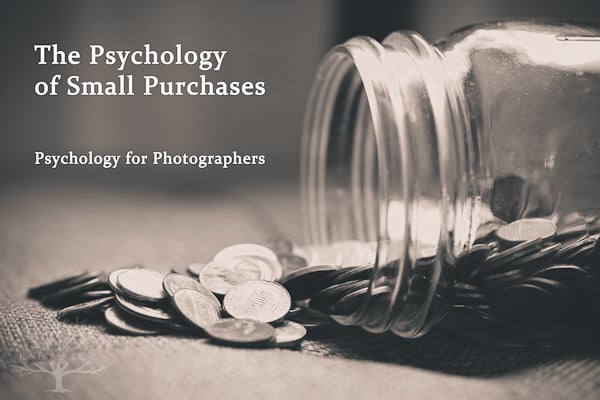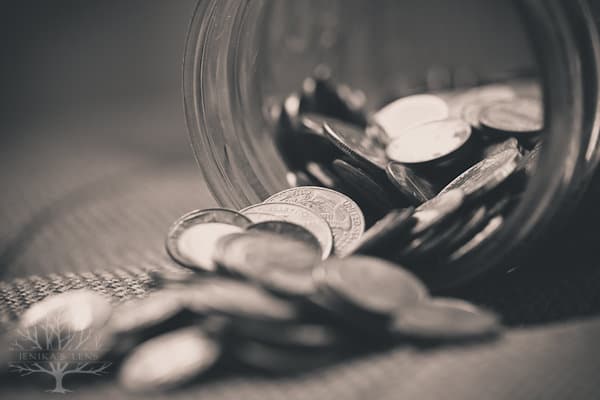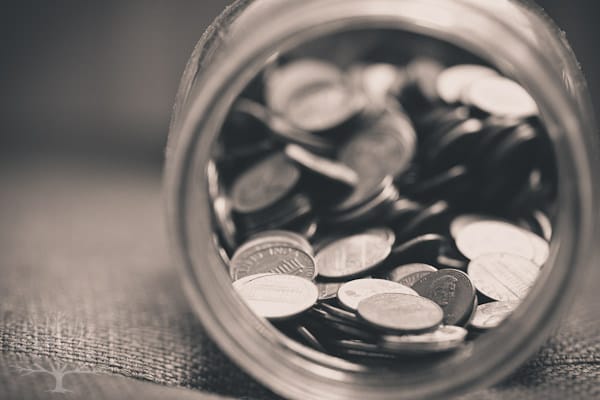The Blog Library
“Cheap Clients” and The Psychology of Small Purchases
So, after a gorgeous, well-lit, beautifully-styled session, you present your images…and are a bit bewildered by the client’s actual purchases.
The client spent hours preparing for the session, but they only buy a handful of 4x6s. Or they opt for the 11×14 when they squealed over the 20×30 during your consultation. Or they decided to get twelve 8x10s instead of the single, beautiful album that would have served them much better.
Why? Because everything else was “too expensive.”
It’s tempting to chalk these things up to brazen cheapery, the vestiges of coupon and DIY culture, or plain old bargain-hunting. And sometimes, that’s involved.
But there’s more to it than “cheap.”
Have you ever gone to a discount store and tossed several $1-$2 items in your cart, thinking “meh, what can it hurt?” only to be surprised with a $19 total at checkout?
Or won a few steal-of-a-deal eBay auctions, then gasped when you realize you just spent $52?
Yeah, me too.
It’s psychologically easier to make several small purchases than single large purchase.
Even if you end up spending the same amount.
There are at least two psychological effects that play into this. One is called “the denomination effect” – our tendency to spend four quarters more easily than we do a dollar. We hate breaking a bill, but will easily fritter away the same amount in change.
For example: In one study, researchers gave participants a dollar as payment for doing a task. They either handed them four quarters or a $1 bill. Then, they asked each participant if they wanted to buy some candy.
Of the people that had been given quarters, 63% chose to buy candy. Those that had been given the $1 bill? Only 26% bought anything.
And of those that bought candy, the people who had quarters spent twice as much as those who had the $1 bill.
(Similar results were found when researchers have looked at larger amounts, like five $20 bills vs. one $100 bill.)
We hate giving up “big” bills, and can more easily give up smaller ones – even though it’s the same amount. And once we give up a small bill, we sometimes say “what the heck” and end up spending more than we would have if we’d broken the large bill.
Professor Joydeep Srivastava of the University of Maryland told Time Magazine: “We tend to isolate the cash in our minds. Each $20 is a separate, less valuable entity than that single $100 bill. So it’s easier to part with five of those twenties than with a single precious hundred in our pockets.”
Although the study was looking at spending rather than pricing, I suspect that five $20 prints are easier to swallow than a single $100 print. It’s easier to keep buying than it is to swallow one lump sum.
This “I hate buying expensive things” attitude is also due to something called the total expenditure effect –
People are more sensitive to price when the amount in question makes up a larger percentage of their total income.
Suppose you have a client (say, a mom who does freelance work), and her monthly after-tax income is $1200.
And a session plus a nice package with you costs $1200.
She’ll probably look at that and say “WHAT?! That’s an entire month’s pay!!” And she’ll stomp off to find something cheaper.
However, maybe she’s also the kind of person who spends $100 a month (including tip) on a deluxe mani/pedi at a local salon. Over the course of a year, she’s still spending a total of $1200 – one month’s income.
However, because she’s doling it out $100 at a time (8.3% of her monthly income each month), rather than a lump sum of $1200 (100% of her monthly income), she will probably have a lower threshold for indulging in a mani/pedi habit.
Even though it’s the same amount spent.
This idea recently spread through the photography community like wildfire.
In the viral blog post “A letter on my doorstep,” the author describes how she canceled a $500 portrait session, but then went on to spend $200+ on other things. (Of course, other things besides photography make us feel good and are worthwhile!) Much discussion arose about what we buy, relative merits, and lasting value.
And some of that boils down to the simple fact that it’s easier to spend money bit by bit than all at once.
So what do we do?
We can’t make custom photography inexpensive for our clients. (Interestingly, neither can Wal-Mart these days.)
But maybe we can reframe spending decisions.
I experienced this just last month: For my birthday, my sweet husband saved up, splurged, and gifted me an iPad mini.
Knowing my love for beautiful home decor, though, he also gave me the option of returning the iPad and spending the money at Pottery Barn, Crate and Barrel, or Restoration Hardware instead.
While still getting over the surprise (so generous of him!) I did browse those stores, but the whole time I was thinking in my mind: Is this worth as much as an iPad to me? Will I get as much enjoyment out of that $150 lamp and a couple $20 candles as I will out of an iPad? For me, the conclusion was “no.” I wouldn’t engage with a lamp as much as an iPad (I can’t Skype with family with a lamp, can I?), and $20 candles will – literally – disappear.
When I compared an iPad directly to the other beautiful items, I ended up making a very different decision than if the choice had simply been “how do I spend $300.” If he had simply handed me the money, I probably would have felt pressed to buy several less expensive items than one expensive one.
Even if the single expensive one was more valuable to me.
Given what we know about the “denomination effect” and the “total expenditure effect,” I wonder if we might challenge our clients to reframe how they think of spending money on photography.
Because if they DIY’d their mani-pedis for a year, they would have enough for a portrait session and small album. If they substituted family walks for a monthly gym membership they never actually use, they’d have enough for your top package.
I wouldn’t advocate telling them “Hey, why are you wasting your money on that crap, my stuff is way better!!” – everything has value, and we don’t want to throw other business owners under the bus.
Rather, the point is that if they thought of a photo session as the equivalent of spending $99 a month to ensure they’d have art created from their life that year, they might make a different choice than if they thought of it as a $1200 decision.
At the very least, understanding the psychology of small purchases will help you approach selling.
Because it’s easy to become shaken or bitter about clients backing away from beautiful work and scrambling to find cheaper solutions. It makes you, the service provider, feel undervalued when someone gasps at your pricing. But it’s not about you being “too expensive” – part of it is that your work is an “all at once” expense.
You could use this knowledge to help them reframe the price. For example, if they balk at the price of the 16×24 canvas, you could ask “Well, here’s another way to think of it: Is it worth $24 a month to you to gaze at this photo every night while you go to sleep for the next year? To fill that space above your dresser and feel happy when you see it?” Maybe, maybe not.
But whatever you do, if they start scrambling on pricing, don’t start scrambling with them. Stay firm on the value of your work, and remember that you’re often battling a person’s natural instincts, not their personality, when you encounter sticker shock. Focus on meeting their needs, give them outstanding service, and where possible, help them put the pricing in a different perspective.
Did you enjoy this post? Stay in touch with Psychology for Photographers, get updates + special deals, and instant access to a free e-book. Just drop your info below!






this is a great post. would love more about this subject!
Thanks Joy! More on pricing concepts to come.
Thanks Jenika, this was really interesting! Taking it all onboard- does this mean that it could be better to have a higher session fee that includes a print credit- in effect breaking up the amount they pay (some in the session fee, some at the ordering session)?
Hey Angela! I’m not sure that these principles, in particular, are an argument for completely restructuring your pricing. I share these more because the dominant narrative in the photography world seems to be “look at all these cheap people out there – ridicuous! sniffle, huff.” And there ARE “cheap” people, but that’s not the only reason for the behavior we see.
That being said, I do know photographers who have done away with a session fee altogether and instead charged something like a $200 retainer that was then credited back to them as a print credit. These folks have reported that once the client starts spending that, it feels easier to buy more. That may have more to do with the sunk cost effect and “priming the pump” than what I described above. Perhaps fodder for a future post. My main goal with this one was to help people see past the “cheap” narrative, and also to suggest one way to reframe pricing (e.g. helping them compare the investment to other things, or framing it in smaller doses.) 🙂
I would like to hear how you apply this to wedding photography.
Hi Tia! As I said in a response to another comment, the goal of this post was to add some nuance to a dominant narrative I see all the time in the photography world: that when clients don’t want to pay high prices or balk at the cost of something, it means they’re “cheap.” That’s not all there is to it, and I think we should take time to walk through some alternative explanations. In this particular post, I’m not arguing for any particular change in how we do things, except perhaps to help clients see how lots of small things can add up, or to mentally have them break down the cost into something that makes more sense to them. Back to your comment, there’s not much we can do to make ourselves fit into the “less expensive” category. You could set up a payment plan of some kind (installments of 50-50% or 30-30-40%) and then have a bonus if they do pay in a lump sum. Lots of online retailers do that for big-ticket items. (However, that puts more administrative pressure on you to ensure payment.) There are other pricing framing techniques that I’ll blog about in the future – stay tuned! For now, the main goal of this was to help people see past the “people are cheap” assumption and understand more of how people actually look at prices.
Great post, as usual, Jenika. One question unrelated to the topic itself: did you use your tilt-shift lens for the photographs for this post? The focus looks like it to me, but I just wondered. I love the film-like processing on them, too.
Thanks Janelle! These photos were grabbed quickly with the 100mm macro. 🙂
I used to work at a portrait studio chain in the UK, which priced their products at the higher end of the market.
They offered monthly payment schemes, which was the option taken by the majority of customers.
The effects you mention are often used by those offering credit for expensive items – “You can have this $1200 portrait for only $100 a month”
Obviously, there are pros and cons to actually offering payment plans, but the theory behind it is similar.
I am really liking this blog. Like any photographers starting out, I priced myself shoot-n-burn style and also had different products like album, prints, etc priced separately.
Shoot-n-burn literally means, I charge to photograph weddings, edit and burn them to DVDs and call it a day.
On average, about 95% of my clients would also add albums with the ‘start up shoot n burn’ price.
When my packages were structured this way, I averaged 25-32 weddings per year.
One year, I decided to get fancy and included the album in the pricing to sell more album. So what was $1000 as starting package, I had $1800.00 (including album).
Because of that change in the packaging, I only had 18 weddings that year. So weird.
If they want to make a large purchase, I will be more than happy to offer them a payment plan. Depending on the total, they can break it up into 3-6 monthly payments. I also require a deposit at the time of the session which is applied to their purchase, so that is money already spent.
Thanks for spelling out this concept. I really struggle to sell large works in my studio. I absolutely adore the huge $1,000 canvases and acrylic mount prints, but $1,000 does sound like a lot of money!
Do you think that offering monthly payments on a large purchase would have the same effect? Or psychologically is it still seen as one large purchase?
I love this article. I have been struggling to find the right words to explain this to a younger family member.
We see a lot of this discussion in fashion. Buy one quality item Vs 10 disposable items.
But you have nailed it. The illustrations … very well written. I would love to see more on this topic.
Each market will value a product differently. Also aesthetics plays a big role as well as perceived value. In the upper income brackets the thinking might be different compared to say clients that are more affected by the economy and the recession? Interesting post!
This is an excellent post, and I found myself thinking of my own examples while reading it. Such as all the small photography equipment I bought to save money, but added up to (and more) the one big piece of equipment I thought I couldn’t afford.
I’m going to think about how to use this in my own business. Thanks again.
Wow this is a great topic! To maximize revenue, consider the follow-up model, which breaks spending up over time. For example, if you take summer wedding photos, even if you’ve already given the couple all the photos and albums and closed their file, think about reaching out to them in October / November and offering custom cards using one of the wedding photos. SEND them a card or 2 with their photo on it so they will see the potential. (even if they don’t buy, they might refer you to others) Yes, it is the type of thing people could easily do themselves – but the convenience and professionalism of a trusted photographer doing it for them, often beats out people’s instinctive ‘cheapness.’ And since you’re doing it several months later, they’ll forget about the hundreds of dollars they already paid you in the past!
Thanks for this outstanding follow-up comment, Sam! I think your suggestion is GOLDEN!
Just re-read this post Jenika, loved it the second time around as well. It really resonates with me as I offer payment plans on purchases. People are much more likely to spend big when it’s broken down into x number of $100 per week payments, rather than a big lump sum up front. Especially as I’m not set up to take credit card payments!
Soooo helpful! A really insightful post – whilst reading I kept thinking ‘yup, that’s how I would look at spending!’ You’ve translated this concept so well!
I devoured this post, as I typically do, with the topics you write about. Fascinating read!